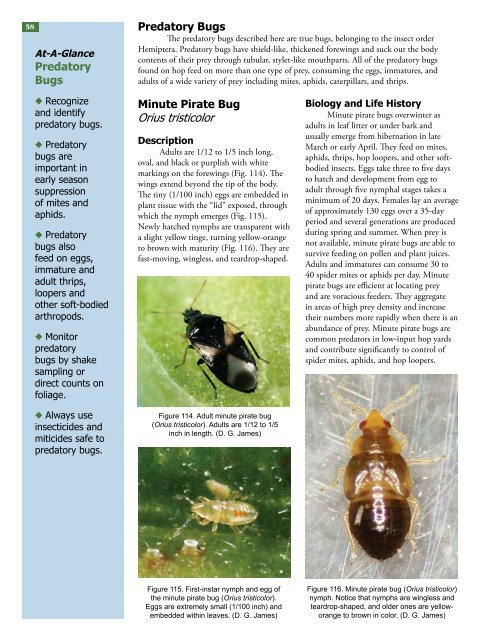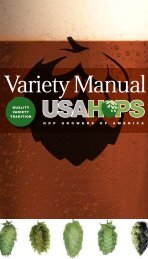Mite FeedersMite-Eat<strong>in</strong>g Lady BeetlesStethorus picipes, S. punctillumDescriptionMite-eat<strong>in</strong>g lady beetles are black,t<strong>in</strong>y (1/25 to 1/16 <strong>in</strong>ch), oval, convex, andsh<strong>in</strong>y, covered with sparse, f<strong>in</strong>e, yellowishto-whitehairs (Fig. 110). Emerg<strong>in</strong>g adultsare reddish-orange <strong>for</strong> a few hours be<strong>for</strong>eturn<strong>in</strong>g black. The white, oval eggs are lessthan 1/50 <strong>in</strong>ch long, and turn dark justbe<strong>for</strong>e the larvae emerge (Fig. 111). Eggs arelaid s<strong>in</strong>gly, usually on the underside of leavesnear the primary ve<strong>in</strong>, and adhere tightlyto the leaf. The newly hatched larva is grayto blackish and has many long-branchedhairs and black patches (Fig. 112). Thelarvae grow from 1/25 to 1/16 <strong>in</strong>ch long,becom<strong>in</strong>g reddish as they mature, at first onthe edges of the body. Just prior to pupationthe entire larva turns reddish. The pupaeare black and flattened, somewhat po<strong>in</strong>tedon the posterior end, with the entire bodycovered with yellow hairs (Fig. 113).Mite-Feed<strong>in</strong>g Lady BeetlesMonitor<strong>in</strong>g, Importance<strong>in</strong> IPM and Compatibilitywith <strong>Pest</strong>icidesMite-eat<strong>in</strong>g lady beetlesare critical to good biologicalcontrol of spider mites. One ortwo Stethorus beetles are usuallysufficient to control an early-seasonmite “hot spot,” prevent<strong>in</strong>g it fromspread<strong>in</strong>g <strong>in</strong>to a larger outbreak.In comb<strong>in</strong>ation with predatorymites, Stethorus may ma<strong>in</strong>ta<strong>in</strong> nondamag<strong>in</strong>glevels of spider mitesdur<strong>in</strong>g July and August. Monitor<strong>in</strong>gcan be conducted by exam<strong>in</strong><strong>in</strong>gleaves <strong>in</strong> the field or a laboratoryby look<strong>in</strong>g <strong>for</strong> t<strong>in</strong>y alligator-likelarvae or mobile p<strong>in</strong>head-sized blackdots. The beetles also can be shakenfrom b<strong>in</strong>es and collected onto atray. Stethorus spp. are susceptibleto broad-spectrum <strong>in</strong>secticidesand miticides such as abamect<strong>in</strong>.However, many narrow-spectrumpesticides are compatible with thesurvival of these important predators.TOP: Figure 110. Adult mite-eat<strong>in</strong>g lady beetlesare 1/25 to 1/16 <strong>in</strong>ch long. MIDDLE: Figure111. White, oval eggs are less than 1/50 <strong>in</strong>chlong. BOTTOM: Figure 112. Newly hatchedS. picipes larva is dark and hairy, with blackpatches. (3 photos, D. G. James)Biology and Life HistoryStethorus picipes (a native species) ismost commonly found <strong>in</strong> hop yards butS. punctillum (exotic) also occurs. Bothspecies are found <strong>in</strong> hop yards not exposedto broad-spectrum pesticides and arevoracious spider mite feeders, consum<strong>in</strong>g 50to 75 mites per day. Overw<strong>in</strong>ter<strong>in</strong>g occursas non-reproductive adults <strong>in</strong> protectedhabitats (e.g., <strong>in</strong> ground debris, under bark)away from hop yards. Adults emerge fromhibernation sites <strong>in</strong> late March and April, andseek out spider mite colonies <strong>in</strong> hop yards,which they are able to do extraord<strong>in</strong>arilywell. Once prey is found, female Stethorusfeed and lay eggs (approximately 15 eggs perday), rapidly exterm<strong>in</strong>at<strong>in</strong>g small colonies ofmites. Larvae develop through four <strong>in</strong>stars,pupat<strong>in</strong>g after 12 days. Development fromegg to adult takes approximately three weeksand three to four generations are produceddur<strong>in</strong>g spr<strong>in</strong>g-summer. Adults live <strong>for</strong> fourto eight weeks dur<strong>in</strong>g summer and thrive attemperatures between 68 and 95 °F.At-A-GlanceMite-Feed<strong>in</strong>gLady Beetles◆◆Monitor <strong>for</strong>mite-eat<strong>in</strong>g ladybeetles.◆◆Learn torecognize “blackdot” adults andalligator-typeblack larvae.◆◆Thesevoracious spidermite feedersconsume 50 to75 mites per day.◆◆Spider mite“hot spots” canbe suppressedby 1 or 2 miteeat<strong>in</strong>gladybeetles.◆◆Use only<strong>in</strong>secticides andmiticides safe tomite-eat<strong>in</strong>g ladybeetles.17 57Figure 113. Pupae of the miteeat<strong>in</strong>glady beetle S. picipes.Notice the po<strong>in</strong>ted posteriorend and yellow hairs cover<strong>in</strong>gthe body (D. G. James)
58 Predatory BugsThe predatory bugs described here are true bugs, belong<strong>in</strong>g to the <strong>in</strong>sect orderAt-A-GlancePredatoryBugsHemiptera. Predatory bugs have shield-like, thickened <strong>for</strong>ew<strong>in</strong>gs and suck out the bodycontents of their prey through tubular, stylet-like mouthparts. All of the predatory bugsfound on hop feed on more than one type of prey, consum<strong>in</strong>g the eggs, immatures, andadults of a wide variety of prey <strong>in</strong>clud<strong>in</strong>g mites, aphids, caterpillars, and thrips.◆◆Recognizeand identifypredatory bugs.◆◆Predatorybugs areimportant <strong>in</strong>early seasonsuppressionof mites andaphids.◆◆Predatorybugs alsofeed on eggs,immature andadult thrips,loopers andother soft-bodiedarthropods.◆◆Monitorpredatorybugs by shakesampl<strong>in</strong>g ordirect counts onfoliage.◆◆Always use<strong>in</strong>secticides andmiticides safe topredatory bugs.M<strong>in</strong>ute Pirate BugOrius tristicolorDescriptionAdults are 1/12 to 1/5 <strong>in</strong>ch long,oval, and black or purplish with whitemark<strong>in</strong>gs on the <strong>for</strong>ew<strong>in</strong>gs (Fig. 114). Thew<strong>in</strong>gs extend beyond the tip of the body.The t<strong>in</strong>y (1/100 <strong>in</strong>ch) eggs are embedded <strong>in</strong>plant tissue with the “lid” exposed, throughwhich the nymph emerges (Fig. 115).Newly hatched nymphs are transparent witha slight yellow t<strong>in</strong>ge, turn<strong>in</strong>g yellow-orangeto brown with maturity (Fig. 116). They arefast-mov<strong>in</strong>g, w<strong>in</strong>gless, and teardrop-shaped.Figure 114. Adult m<strong>in</strong>ute pirate bug(Orius tristicolor). Adults are 1/12 to 1/5<strong>in</strong>ch <strong>in</strong> length. (D. G. James)Biology and Life HistoryM<strong>in</strong>ute pirate bugs overw<strong>in</strong>ter asadults <strong>in</strong> leaf litter or under bark andusually emerge from hibernation <strong>in</strong> lateMarch or early April. They feed on mites,aphids, thrips, hop loopers, and other softbodied<strong>in</strong>sects. Eggs take three to five daysto hatch and development from egg toadult through five nymphal stages takes am<strong>in</strong>imum of 20 days. Females lay an averageof approximately 130 eggs over a 35-dayperiod and several generations are produceddur<strong>in</strong>g spr<strong>in</strong>g and summer. When prey isnot available, m<strong>in</strong>ute pirate bugs are able tosurvive feed<strong>in</strong>g on pollen and plant juices.Adults and immatures can consume 30 to40 spider mites or aphids per day. M<strong>in</strong>utepirate bugs are efficient at locat<strong>in</strong>g preyand are voracious feeders. They aggregate<strong>in</strong> areas of high prey density and <strong>in</strong>creasetheir numbers more rapidly when there is anabundance of prey. M<strong>in</strong>ute pirate bugs arecommon predators <strong>in</strong> low-<strong>in</strong>put hop yardsand contribute significantly to control ofspider mites, aphids, and hop loopers.Figure 115. First-<strong>in</strong>star nymph and egg ofthe m<strong>in</strong>ute pirate bug (Orius tristicolor).Eggs are extremely small (1/100 <strong>in</strong>ch) andembedded with<strong>in</strong> leaves. (D. G. James)Figure 116. M<strong>in</strong>ute pirate bug (Orius tristicolor)nymph. Notice that nymphs are w<strong>in</strong>gless andteardrop-shaped, and older ones are yelloworangeto brown <strong>in</strong> color. (D. G. James)








